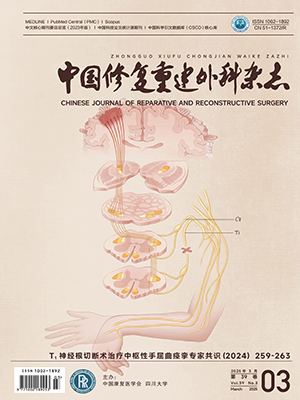Objective To investigate the operative procedure and the cl inical results of reverse lateral tarsal artery flap in treating forefoot skin and soft tissue defect. Methods From August 2007 to April 2009, 11 patients with forefoot skin and soft tissue defect were treated with reverse lateral tarsal artery flaps, including 7 males and 4 females aged from 16 to 60 years
(36 years on average). Of 11 cases, defects were caused by crash in 5 cases, by grind contusion in 3 cases and the course disease was 4-12 hours; by tumor extended resection in 3 cases and the disease course was 3-12 months. There were 5 wounds on the dorsum of first metatarsophalangeal joint, 2 on the dorsum of the first toes, and 4 on the dorsum of distal part of metatarsal bones. The area of defect ranged from 4 cm × 2 cm to 6 cm × 5 cm. There were 6 cases of tendon exposure, 4 cases of tendon defect with bone exposure, and 1 case of tendon defect with open dislocation of metatarsophalangeal joint. The flap was designed with dorsal artery of foot as its pedicle. The plantar perforating branch was designed as its rotating point. And the flaps were transferred retrogradely to repair the forefoot wounds. The flap area ranged from 4.5 cm × 2.5 cm to 6.5 cm × 4.5 cm. The lateral dorsal nerve of foot was anastomosed with the nerve in wound area in 7 cases. Donor site was covered by full thickness skin graft. Results Partial necrosis occurred and was cured by dressing change, followed by skin graft in 2 cases. The flaps survived and primary heal ing was achieved in the other 9 cases. All the skin grafts of donor site survived and primary heal ing was
achieved after operation. All the patients were followed up for 6 months to 2 years, averaged 13 months. The texture and color of the flap were similar to skin at the recipient site. All patients returned to normal in walking and running and no ulceration occurred. The two point discrimination was 5-12 mm 6 months after operation in 7 patients who received nerve anastomosis, while only protective sensation recovered partly in the other 4 patients whose cutaneous nerve were not anastomosed. Conclusion Reverse lateral tarsal artery flap has the perfect shape and its blood vessel is constant. The blood pedicle is thick and long enough when transferred retrogradely. The flap is a good choice in the treatment of forefoot skin and soft tissue defect.
Citation: MIAO Weihua,LIU Zhen,XU Chao.. REPAIR OF FOREFOOT SKIN AND SOFT TISSUE DEFECT WITH REVERSE LATERAL TARSAL ARTERY FLAP. Chinese Journal of Reparative and Reconstructive Surgery, 2010, 24(1): 53-56. doi: Copy
Copyright © the editorial department of Chinese Journal of Reparative and Reconstructive Surgery of West China Medical Publisher. All rights reserved




